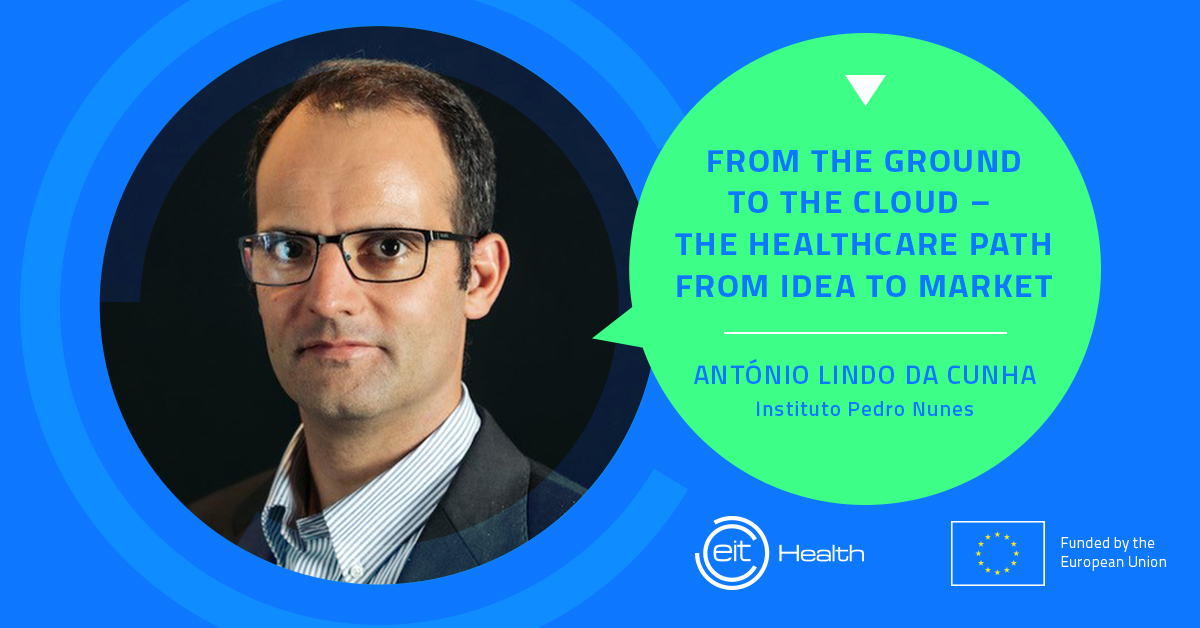28th April 2021

Cloud-connected medical devices are an opportunity to implement Health 4.0, closing the clinical loop between patient and health professionals. However, the pathway from an idea to a marketable medical device is loaded with several challenges and barriers. Views on that gives Antonio Lindo da Cunha, Executive Director, Laboratory of Automatic and Systems at Instituto Pedro Nunes.
The MedTech companies need to follow up a complex chain with several steps and different stakeholders. This journey is particularly challenging for start-ups that have difficulty in understanding and planning all steps and procedures that they must take to reach the market.
Do you want to learn more? Register for the free webinar here.
Usually, most of the MedTech innovations are technology-driven and entrepreneurs believe that a good idea with a good technology suffices to be successful. While technological innovation to solve current clinical needs may continue to drive the development of new technology, in most cases, it is not enough to reach the clinic. In fact, entrepreneurs need more than ever to establish the value and impact of their innovative medical technology products and services and be aware that the healthcare industry is heavily regulated, which requires spending considerable time and resources and legal issues.
For that reason, it is necessary to empower the start-ups, among others, in acceleration programmes with specific knowledge and tools that allow the start-ups to plan their product development activities more realistically.
First, a start-up needs to be aware of the health innovation pathway: the health care sector has many stakeholders, each with an agenda, requirements and expectations. The CIMIT (Consortia for Improving Medicine with Innovation and Technology) suggests a clear Healthtech Innovation Cycle, which presents a journey from identifying an unmet need from healthcare to the development of a marketable solution. CIMIT divides an innovation’s lifecycle into 10 stages, allowing companies and stakeholders to have a firmer grasp on the status of their innovation at any time. This approach represents a considerable improvement when compared with the TRL (Technology Readiness Levels), since it is much more than a simple maturity classification. Beyond the 10 stages, the methodology suggests four main activities that should run in parallel during the whole cycle (clinical, market, regulatory and technical). This approach contradicts the previous reality where the technology plays a central role in the development process, leaving the regulatory and clinical issues for the later stages.
To guide the development and to ensure the impact in three main healthcare stakeholders (3P: patient, provider and payer), CIMIT emphasizes the importance of evidence-based technology development and comparative effectiveness research. Health Technology Assessment (HTA) is the preferred method for this analysis. HTA is a method of evidence synthesis that considers evidence regarding a set of topics such as quality, clinical effectiveness, safety, cost-effectiveness, comparative effectiveness. It also covers social, economic, ethical, and legal aspects of the use of health technologies.
There is a growing recognition of value demonstration and HTA plays an increasing role in the pricing, reimbursement and coverage decision-making processes for medical devices.
Evaluating the proposed approach from the earlier stages is essential mainly for two reasons: firstly, it will give an opportunity to stop or pivot if the results suggest that the product is unlikely to provide clinically meaningful improvement or that it could not demonstrate the economic value, avoiding to waste resources; and secondly, the evaluation will influence the shape of the solution. The evaluation in earlier stages (eHTA) is also particularly important to get the solution funded, for example by using public tenders or private investment. Again, it’s very common to see proposals guided by a technology-push approach without including a clear evaluation of the clinical effectiveness justification using validated methodologies.
A third topic that imposes considerable constraints on the MedTech start-ups’ journey is the standardization and regulatory barriers. The regulatory process is a very specialized procedure where it’s necessary to frame the product intended purpose in the complex legislation. Taking into consideration the background of the entrepreneurs that normally does not include these skills, the regulatory approval represents one of the biggest challenges for the life of the company, in particular in the first years. It’s frequent that the entrepreneurs get blocked in a chicken and egg situation. They need to test the product in a relevant environment or they even need to start selling the first products in order to convince the investors, but without financial resources to support the certification they cannot move forward.
If the current regulatory process is already a potential obstacle in the start-ups’ journey, the procedure won’t be easier if we consider the new regulation that will be in operation next month. The new framework will bring more complexity and requirements; for example, all medical devices (in all classes) will need to have ISO 13485 certification. Until now, only the medical devices with class IIa, IIb and III needed to have their management system certified. Another new requirement is the obligatoriness of registration in the European Database on Medical Devices (EUDAMED), where medical devices market players, such as manufactures, European representatives and importers, should register themselves and their linked products. According to the new regulation, all the MD need to obtain a Unique Device Identification (UDI) and until now only four organizations in the world could assign this identification. It will also be necessary to have a formal procedure for post-market surveillance and clinical follow-up to assure that the initial assumptions remain over time and that the products that we have on the market are safe and secure.
Understanding all these potential challenges and barriers in advance and designing an efficient strategy will make it possible to save time and money in the long term. For a start-up, this can be the difference between success and failure.
The “The Healthcare Path from idea to market” seminar focuses mainly on health start-ups, and will address these three main topics: the CIMIT framework, the HTA, and the regulatory process, by bringing together invited representatives from the MedTech area to present, discuss, and debate these topics. You are invited.
Europe's top health start-ups take centre stage: EIT Health Catapult winners are revealed at HLTH Europe

2025 Catapult programme winners announced.
Finding Europe’s next healthtech leaders: Insights from Antoine D’Hollander

Insights from Antoine D’Hollander, Capricorn Partners.
EIT Health supports 17 promising deep tech start-ups bridge the ‘Valley of Death’

Providing start-ups with the right support.